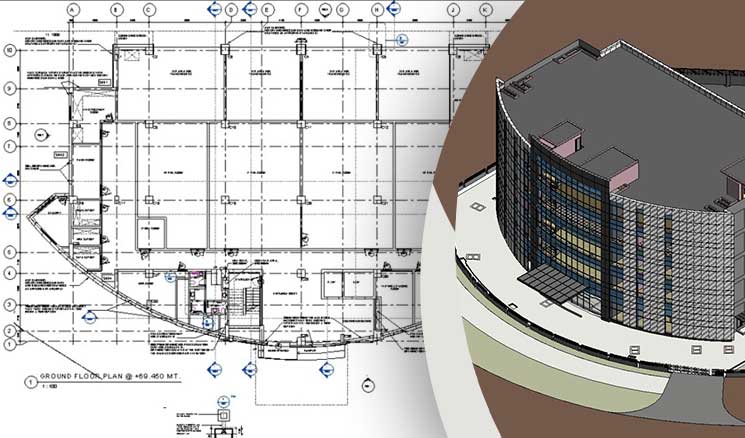Small and medium-sized construction businesses achieve significant investment returns through the implementation of Building Information Modeling (BIM). The article examines how BIM technology generates financial benefits through cost reduction and process optimization which enables businesses to achieve better profitability and sustainable growth.
Small and medium-sized construction companies face significant challenges when they consider adopting new technology because it requires substantial investment. The limited financial resources of small businesses face intense project requirements while their concern about workflow disruptions remains a major obstacle. Building Information Modeling (BIM) stands as a transformative technology that delivers substantial benefits to construction companies of all sizes.
BIM technology has evolved beyond its original purpose of serving large corporations and massive construction projects. Small businesses that implement 3D BIM modeling through BIM technology experience quantifiable benefits which enhance operational efficiency and decrease mistakes while creating fresh market prospects. The following article explains how BIM generates ROI for small and medium construction businesses while demonstrating its value as a strategic business investment.
What is BIM and Why Does It Matter for Smaller Firms?
BIM represents a digital construction method which generates smart 3D parametric models that include complete data about building elements. The BIM implementation enables real-time collaboration and data-driven decision-making through its intelligent 3D models which also perform clash detection.
BIM technology provides small and medium-sized businesses with three main advantages which include:
- Improve accuracy and reduce costly mistakes
- Streamline workflows with BIM automation
- Enhance communication with clients and subcontractors
- Support better project management and scheduling with 5D BIM cost estimation
The advantages of BIM implementation lead to increased profits and improved client satisfaction.
Key Areas Where BIM Boosts ROI
1. Reduced Rework and Cost Overruns
Construction site errors become very expensive for small businesses because they maintain minimal profit margins. BIM coordination enables users to detect design problems and construction errors before starting the building process. This means:
- Fewer unexpected change orders through clash detection reports
- Less wasted labor and materials due to automated quantity take-offs
- Reduced risk of costly delays through constructability analysis
BIM technology enables small businesses to save thousands of dollars per project through its ability to minimize rework by 40% according to industry reports.
2. Faster Project Delivery
BIM technology enables firms to complete projects both on schedule and before deadline through its ability to:
- Enhance coordination among subcontractors with federated BIM models
- Enable better sequencing of construction activities using 4D simulation
- Reduce approval times with clearer 3D visualizations and digital twin models
The ability to complete projects quickly leads to faster payment reception and enables the company to handle additional annual projects which directly affects financial performance.
3. Winning More Projects with Better Presentations
The modern client base requires detailed visual presentations which show both value and exactness in their work. BIM visualization tools enables the creation of 3D renderings, walkthroughs, and VR/AR presentations which serve as effective sales materials that:
- Showcase designs in immersive detail with BIM-based visualization
- Help clients understand the scope and quality through interactive BIM models
- Build confidence in your firm’s capabilities with data-rich project presentations
The ability to secure more bids leads to higher revenue and business expansion opportunities.
4. Improved Collaboration and Communication
BIM enables all stakeholders including owners and architects, subcontractors and contractors to work from a unified source of project information.
- Miscommunication with real-time BIM coordination
- Redundant work through model-based documentation
- Conflicts and disputes on-site by using shared project data
The streamlined collaboration process in BIM projects helps small businesses save time and prevent costly interruptions.
5. Efficient Resource and Material Management
BIM models enable firms to generate precise quantity take-offs and material schedules which help them to:
- Order just what’s needed with parametric modeling
- Reduce waste and over-ordering through 5D BIM estimation
- Plan labor and equipment more effectively using resource planning modules
The management of resources through BIM integration leads to lower operational costs and higher profit margins.
Common ROI Metrics for BIM Adoption
The main areas where small and medium construction businesses achieve return on investment include:
| ROI Factor | Impact for Small & Medium Firms |
| Reduction in Rework | 20-40% cost savings |
| Shorter Project Durations | 10-25% faster completion times |
| Increased Bid Win Rate | Improved client trust & competitive edge |
| Lower Material Waste | Reduced procurement costs |
| Fewer Change Orders | Streamlined workflows & lower administrative costs |
Challenges to Overcome
The advantages of BIM implementation remain evident yet smaller businesses face obstacles when deciding to adopt the technology because of:
- Initial training and BIM software costs the implementation of Revit modeling workflows requires changes to workflow operations and staff members need BIM expertise or external BIM services providers.
The positive aspect of BIM tools includes their scalability and affordability together with extensive BIM training resources available to users. The implementation of BIM begins with small BIM projects to help firms determine their full commitment to the technology.
Case Study: Revit Modeling and Clash Detection for a Data Center Building in India
TrueCADD worked with a prominent architectural firm in Gandhinagar Gujarat to create a coordinated 3D BIM model for a data center that included no clashes. The project required the integration of 2D AutoCAD drawings from various subcontractors and management of ongoing design modifications and the coordination of intricate MEP services with service tunnel. Our team used Revit modeling software together with Navisworks clash detection tools to create a federated BIM model which improved documentation and enhanced collaboration while delivering the project on time and within budget.

Deliverables:
- 3D BIM models for architectural, structural, and MEP systems
- Clash detection report using Navisworks Manage
- Sheet Setup & Drawing Documentation
- BIM schedules, quantity takeoffs, and joint details
BIM ROI Optimization Strategies for Construction Businesses
The following strategies will help you achieve maximum BIM ROI benefits:
- Launch pilot BIM projects to establish staff confidence levels.
- Organization should allocate funds to train essential personnel about BIM implementation and Revit software usage.
- Company should work with BIM consultants who possess extensive experience in 4D scheduling, clash detection, and quantity estimation.
- Implementation of BIM should begin during project management, scheduling, and construction sequencing phases.
- BIM data enables construction companies to provide digital twin models and post-construction facility management services.
Conclusion
Small and medium-sized construction businesses should view BIM as a strategic investment because it generates multiple financial benefits. BIM enables construction companies to achieve faster project delivery and reduced rework expenses while securing additional projects and delivering better client satisfaction which leads to sustainable business expansion.
The initial apprehension about BIM services disappears when organizations see the clear financial benefits it delivers. Construction companies that adopt BIM technology now will achieve better success in the digital construction industry of tomorrow.




